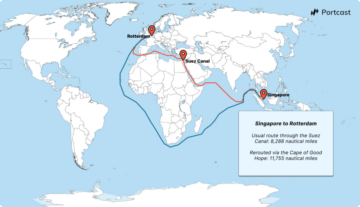
Shortly before the start of the European Football Championship (for our US readers: it’s all about Soccer) this Friday, many Europeans are again feeling the tension and anticipation of this special kind of major sporting event. This is not different for me, even if of course the Corona pandemic makes some things different than one was used to in the past. In any case, I am once again in football mode myself and am looking at many of my professional topics, such as supply chain management, from a football perspective. And on the occasion of the last tournament 5 years ago in France, I had already noticed that football has a lot to do with integrated (supply chain) planning. Here follows an older text (with a few adaptations) that I believe is still valid today.
Modern football relies on a well-functioning team structure
When football coaches are satisfied with their team’s play, they often talk at the press conference about how the team “meshed well” or how the “play in depth” worked well. Basically, they mean that the ball was combined fluidly from the defense to the midfield to the offense. Modern successful football, such as that practiced by reigning world champions France, relies on a well-functioning team structure in which all parts of the team move together toward the ball. The days when the defense confined itself to defending at all costs and the strikers merely waited in the penalty area for the long pass are long gone.
Horizontal combination game to win
In the internal supply chain of a company, there are different planning areas, similar to the team blocks in a football team, which primarily pursue their own goals. The decision-makers in procurement, production and distribution generally ensure that their own processes are planned as optimally as possible. While those responsible in procurement, for example, want to keep their inventories as low as possible, production often wants to utilize capacities as optimally as possible. The question is: Is this enough for the company’s success? Do you think Cristiano Ronaldo would be exuberant about scoring a hattrick if the game ended up being lost 3:4?
A local success can quickly lead to a defeat for the overall result. If the right purchased part is missing from the warehouse, production cannot produce and the customer does not receive his goods on time. Decisions in the individual processes must be made with an overall view of the entire supply chain, otherwise conflicts are inevitable. As in football, the decision-makers in the company must work together as a team to ensure customer satisfaction through an optimal level of service – the ultimate goal of the entire supply chain.
However, this can only be achieved if all sub-disciplines always keep this goal in mind, even if they have to put their own interests aside to achieve it. In the same way, integration into the build-up play is not in the primary interest of the defender, and the striker will not intuitively understand what “helping out at the back” has to do with scoring goals. Now, it is still relatively easy for the striker to recognize that his team just has a defensive problem, but for production it is relatively difficult to include the secondary conditions of procurement in their own planning. It is also a major challenge for many IT systems that the individual pieces of information often cannot be linked in such a way that an optimal overall result is achieved.
Instead of a single system, each process often works with its own specialized software – the IT landscape in companies resembles a patchwork quilt. Integration at the process level is therefore not enough; planning must also be merged with regards to IT. In the meantime, there are systems that include all secondary links of all sub-processes in the calculation of the planning, and thus enable those responsible in their decisions to look beyond the end of their nose. Holistic planning carried out in this way leads to lower inventories (with high availability) as well as robust, optimal production planning and, as an overarching goal, ensures an optimal level of service to the end customer.
Outside the operational playing field, vertical integration is required
What I have described here using the example of a football team on the pitch is referred to as horizontal integration, which is mainly concerned with operations. Of course, you also have to consider the strategic component, which extends from strategic long-term planning through medium-term budget planning to the operational level. Here, too, the goal – whether in football or in business – is basically to ensure that planning is done in unison. Imagine, for example, that the English association has set the goal of winning the European Championship, but the goalkeeper coach of the “Three Lions” has decided to completely forego penalty training (absolutely absurd if you know about the history of English teams with penalties). Or the team doctor considers a player’s injury to be too serious, but the coach still schedules him for the next game because he hasn’t received this information.
While such a situation is actually considered unthinkable for the national team, such prohibitions on thinking seem to have been lifted for companies. Planning takes place in varying depths of detail in a multitude of Excel spreadsheets, which are also often based on a different database. Aggregating such a multidimensional planning space is extremely difficult for the individual decision-maker, and the actual planning situation in the company remains intransparent. An information flow that keeps the vertical planning axis in sync is practically impossible in this way.
Similar to horizontal integration, the solution is an IT system that is used collaboratively by all vertical planning levels. In such a system, responsibilities can be mapped on a rule basis with a single database, and planned figures can be calculated for each planning dimension according to these rules. In this way, operational processes are optimally aligned with strategic decisions, and the current situation in the company can be viewed at any time, right up to the executive level.
Conclusion
As far as integrated planning is concerned, many companies should take an example from teams like France, Portugal or Germany, including their coaching staff. Just as successful coaches like Joachim Löw or Didier Deschamps, for example, have shaped the modern game of their national teams, ultimately even becoming world champions, decision-makers in companies can also implement a modern and successful concept in their processes. This should start in the minds of their “players” and then continue with a suitable IT system. Unless you have star players like Kylian Mbappé, Cristiano Ronaldo or Robert Lewandowski in your team, who practically win the game on their own on good days. But before you buy them from their clubs, you’d better try intelligent software.
- All
- AREA
- availability
- business
- buy
- challenge
- Companies
- company
- component
- Conference
- considers
- continue
- Corona
- Costs
- Current
- Customer satisfaction
- Database
- Defense
- detail
- Dimension
- Doctor
- English
- European
- Europeans
- Event
- Excel
- executive
- flow
- Football
- France
- Friday
- game
- Germany
- good
- goods
- here
- High
- history
- How
- HTTPS
- Including
- information
- integration
- interest
- IT
- lead
- Level
- local
- Long
- major
- management
- move
- nose
- Operations
- pandemic
- perspective
- planning
- Portugal
- press
- Production
- readers
- rules
- secondary
- set
- Soccer
- Software
- Space
- start
- Strategic
- success
- successful
- supply
- supply chain
- supply chain management
- system
- Systems
- Thinking
- time
- Topics
- tournament
- Training
- us
- View
- Warehouse
- WHO
- Wikipedia
- win
- Work
- works
- world
- years
- youtube










